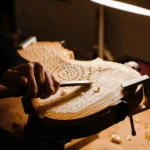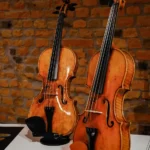Fine Violins – What Makes an Instrument Truly Valuable
Back to BlogFine Violins – What Makes an Instrument Truly Valuable
What defines a fine violin? From world-class soloists to serious collectors, the term “fine violins” is often associated with exceptional quality, history, and tonal beauty. In this article, we’ll explore the core characteristics that make violins truly valuable—and how you can recognize and invest in one.
What Are Fine Violins?
“Fine violins” refers to high-quality, handcrafted string instruments that meet professional standards in tone, craftsmanship, provenance, and market value. These violins are typically made by master luthiers—historic or modern—and are known for their exceptional sound, visual beauty, and rarity.
The Legacy Behind the Finest Violins
Fine violins have a deep historical legacy rooted in Italian violin making. Legendary luthiers like Antonio Stradivari, Guarneri del Gesù, and the Amati family developed techniques in Cremona that continue to define modern violin craftsmanship. Contemporary makers follow these traditions, combining centuries-old methods with their own artistry.
How to Identify a Fine Violin
A fine violin will stand out through several distinctive features:
– Expert craftsmanship and hand-finishing
– A strong provenance and verifiable maker’s label
– High-quality materials like aged spruce and flamed maple
– Unique varnish work and aesthetic character
– A powerful, rich, and balanced tone
Each of these qualities plays a role in establishing the instrument’s worth. Explore our rare Italian violins for sale to see examples of fine craftsmanship.
Why Fine Violins Are Worth the Investment
Fine violins are scarce cultural assets. Whether crafted by historical makers or top contemporary luthiers, they tend to appreciate in value over time. Collectors and musicians alike invest in fine violins not just for their sound, but for their artistry, legacy, and financial resilience.
How Fine Violins Are Valued
Valuing a fine violin depends on five key pillars: the maker’s reputation, condition, tonal performance, provenance, and comparable sales data. These elements form the basis of assessment for musicians and collectors. For a full breakdown, visit our Collector’s Guide to Investing in Rare Violins.
Caring for Fine Violins: The Amorim Lab
At Amorim Fine Violins Cremona, we protect and assess every fine violin with scientific precision. Through The Amorim Lab, we use infrared and ultraviolet imaging, wood density tests, and structural diagnostics to ensure authenticity and condition transparency.
Read how we use science to evaluate fine violins in The Amorim Lab.
Case Study: Investing in a Fine Violin for the Next Generation
One of our recent clients was a father looking to invest in a fine violin for his teenage son, a talented young musician advancing rapidly through conservatory training. The family sought not only an exceptional instrument to elevate the boy’s playing, but also a long-term cultural and financial investment. After a private consultation and tonal testing session, they selected an 18th-century Gagliano violin from Naples. The choice was driven by the instrument’s tonal characteristics—perfect for solo performance—and its strong provenance. This violin now supports both the son’s musical growth and the family’s legacy.
What to Look for When Buying a Fine Violin
When shopping for fine violins, here are some essential elements to consider:
– Is the violin made by a recognized maker or workshop?
– Are there certificates of authenticity and documentation of provenance?
– Has the violin been professionally maintained?
– How does it perform in tonal color, projection, and responsiveness?
– Does it fit your level as a musician, or your goals as a collector or investor?
If you’re unsure how to evaluate these criteria, our team can walk you through the process in detail during a consultation.
Explore Trusted Fine Violins with Confidence
Choosing a fine violin is a highly personal and meaningful decision. At Amorim Fine Violins Cremona, we guide each client with care, transparency, and decades of experience. Whether you’re seeking a historical Italian masterpiece or a contemporary instrument crafted with passion and precision, we’re here to support you every step of the way.
About the Author and Workshop
This article was produced by the editorial team at Amorim Fine Violins Cremona, a family-run workshop established in 2001 by master luthier Luiz Amorim. With decades of experience crafting, restoring, and authenticating fine violins, the Amorim team serves musicians, collectors, and institutions worldwide. We are committed to ethical expertise, scientific precision, and a passion for preserving musical heritage. Find more about us.









